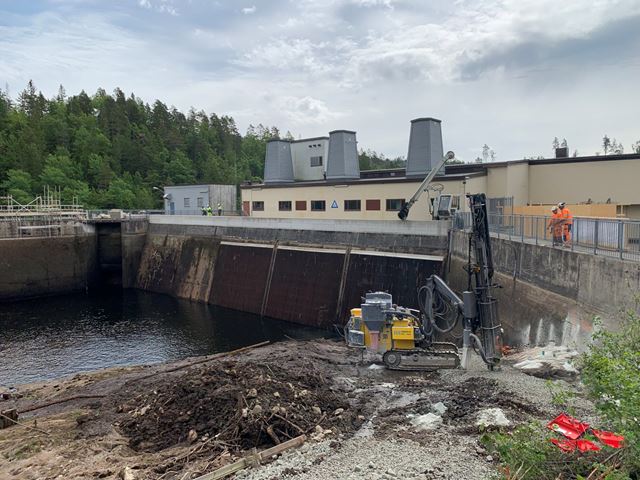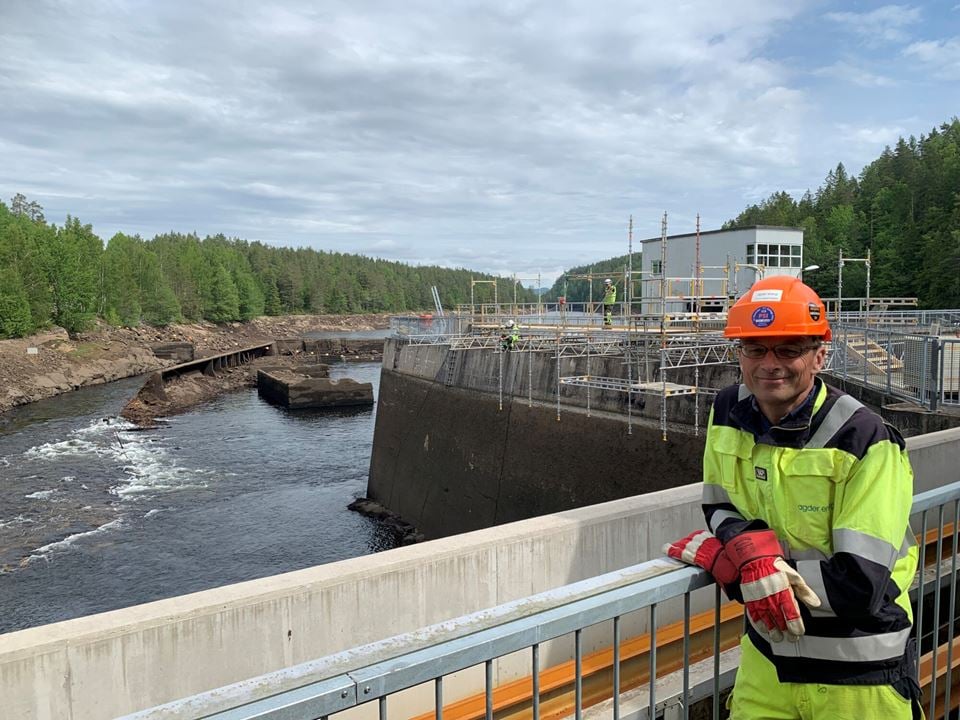“Initially, companies need assistance in identifying the problems”, says Szabo-Meszaros. “Then they need help in solving them. The roadmap offers a selection of possible solutions”, he explains.
Normally, Szabo-Meszaros works as a scientist at SINTEF Energy Research on projects relating to the environmental impacts of hydropower development. Recently, he has also acted as the editor of a new roadmap published by the International Energy Agency (IEA), where the aim is to demonstrate how fish welfare can be improved.
Impacts on fish populations
A new hydropower plant will almost always result in changes to a river and its ecosystems. This will commonly lead to major impacts on fish populations. Fish will be unable to reach areas where they swam in the past, and the physical conditions where they can still live will be changed.

The new dam will be reinforced using concrete that is anchored both in the bedrock and existing dam. Photo: Agder Energi Vannkraft/Å Energi
Both the power companies and researchers have been working for some time to study the impacts of hydropower developments on fish populations. However, Szabo-Meszaros and his research colleagues emphasise that most of this work has been based on the behaviour of very few fish species, and that global acceleration in the planning of new hydropower plants demands international research collaboration.
Identifying the problems
Svein Haugland is one of those who contributed to the roadmap in his capacity as technical manager at the power company Agder Energi Vannkraft, which has now become Å Energi.
“The first thing we need to decide is whether or not the fish should be permitted to pass a new plant”, explains Haugland. “If the answer is yes, then we must continue with the process. Some fish species require one type of technology, while other species require another”, he says.
“The biggest problem is created by physical barriers”, says Szabo-Meszaros. “These barriers serve to obstruct fish migration through the plant infrastructure. However, there are also many problems associated with the various habitat changes that a development will entail. This applies on both the upstream and downstream sides of a plant.

The company STS Stillas is erecting suspended scaffolding that will be used in the work to reinforce the dam. Project Manager Tor Åmdal is seen here looking on. Photo: Agder Energi Vannkraft/Å Energi
“The innovative aspect of the roadmap is that it helps plant builders identify the problems they may be encountering”, says Szabo-Meszaros. “Once they have done this, they can start looking into possible solutions. We’ve gathered together solutions to all kinds of different problems. The combination of local knowledge and ecology informing the power plant owners will eventually help them to decide what types of solutions can be carried forward”, he says.
Hydropower and fish
Research scientists and hydropower experts from twelve countries have been responsible for producing the international Roadmap for Best Practice Management.
Marcell Szabo-Meszaros at SINTEF Energy Research has coordinated the work to produce the roadmap in collaboration with Niels Nielsen, who is a former secretary of the Executive Committee of the IEA Technology Collaboration Programme on Hydropower.
Hans-Petter Fjeldstad at SINTEF was responsible for coordinating the work programme looking into hydropower and fish for seven years. After Fjeldstad died in 2020, Marcell Szabo-Meszaros continued the work.
The report can be downloaded free of charge in PDF format here.
What kind of fish ladders?
Svein Haugland at Å Energi highlights two power plants installed along the Nidelva river in southern Norway.
“At the Rygene plant near Arendal, several species had to be considered for passage through the plant as well as salmon and brown trout”, he says. “So we discarded the pool and weir model in favour of a submerged orifice structure. In a pool and weir ladder model, the water flows from pool to pool and the fish can swim from one pool to the next. In a submerged orifice ladder, water velocity is reduced along the river bed and an opening is created between the pools that extends to the bottom”, says Haugland.
“We’re now building a power plant at Evenstad, a little upstream of Rygene, where we’ve been forced to address the same issues, such as how many species will be allowed to pass through the structure”, he says. “Perhaps it will be easier here to build something other than a submerged orifice ladder. “But if we take a couple of steps back and instead build a pool and weir ladder, we’re saying that we’re only permitting salmon and sea trout to pass upstream”, says Haugland.

The new dam will be reinforced using concrete that is anchored both in the bedrock and existing dam. Photo: Agder Energi Vannkraft/Å Energi
In addition to guidelines on how to enable fish to pass through hydropower plants, the roadmap also offers advice on everything from temperature and sediments to gas oversaturation.
Disseminating knowledge
“Our challenge now is how to disseminate all this knowledge”, says Torodd Jensen. Jensen has been heading the IEA’s collaborative projects in the field of hydropower technology, and has recently retired from his position as a Senior Engineer at the Norwegian Water Resources and Energy Directorate (NVE).
“IEA reports are for the most part used by actors in member countries”, he explains. “The World Bank and other development banks are familiar with their contents and are thus able to incorporate relevant material in the terms and conditions for project funding”, he says.
“It’s important to be aware that what works along one river will not necessarily be suitable for others”, says Jensen. “There are differences between the rivers of Europe, Asia and Africa. Many of the principles are likely to be similar, but sometimes different approaches must be considered”, he says.

